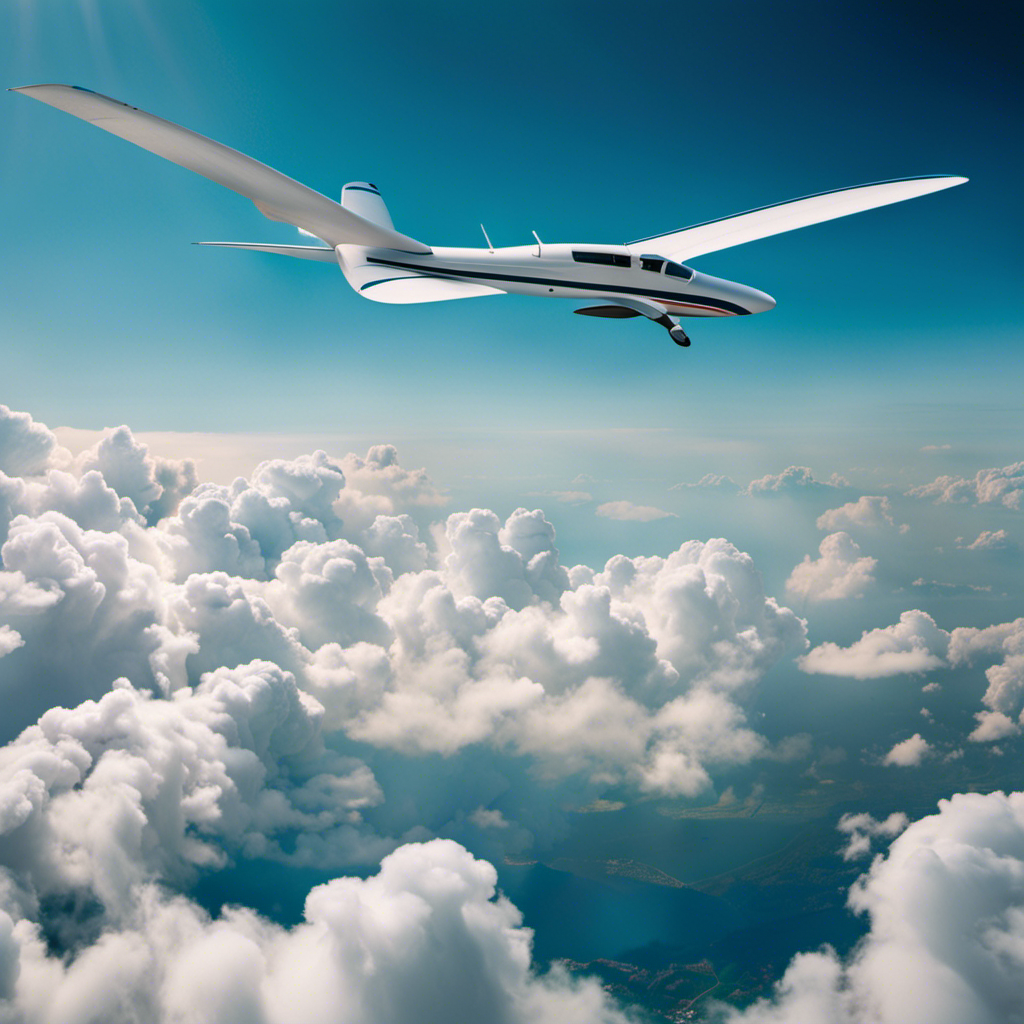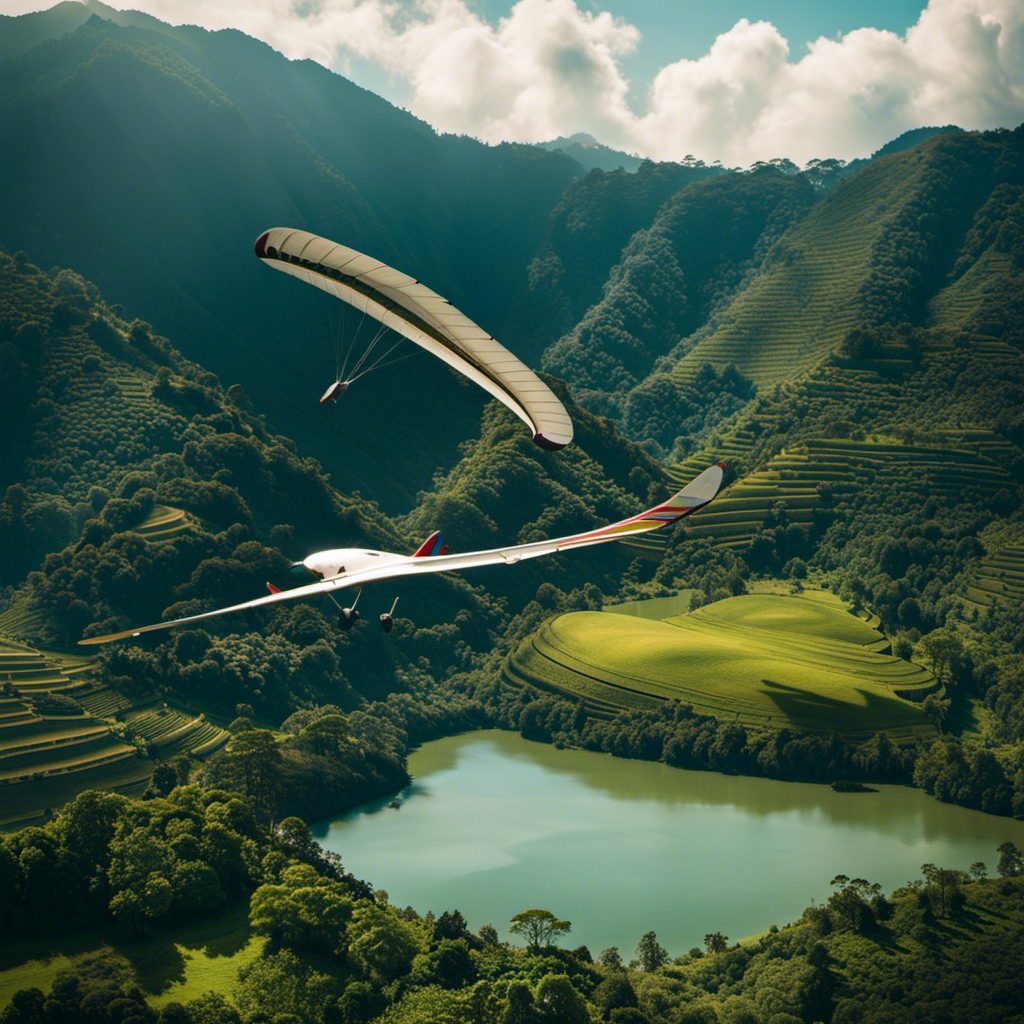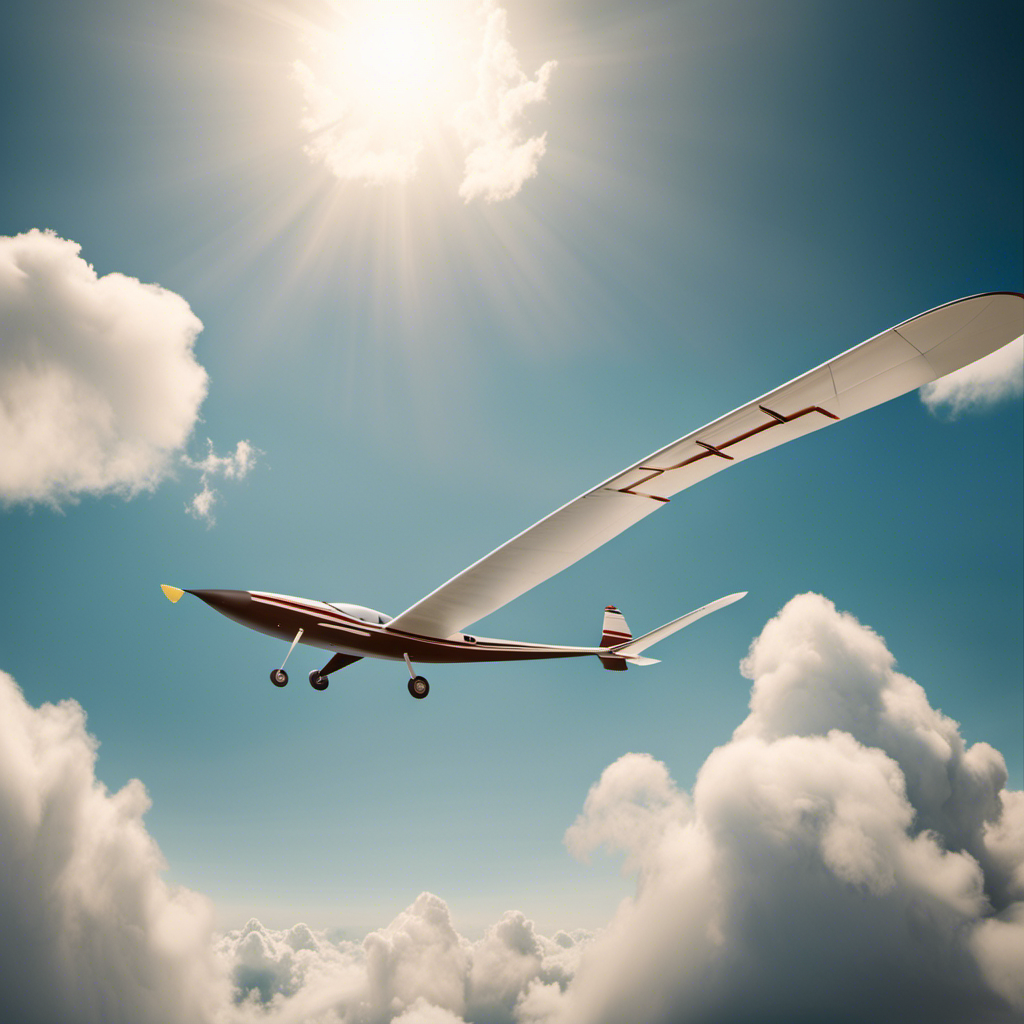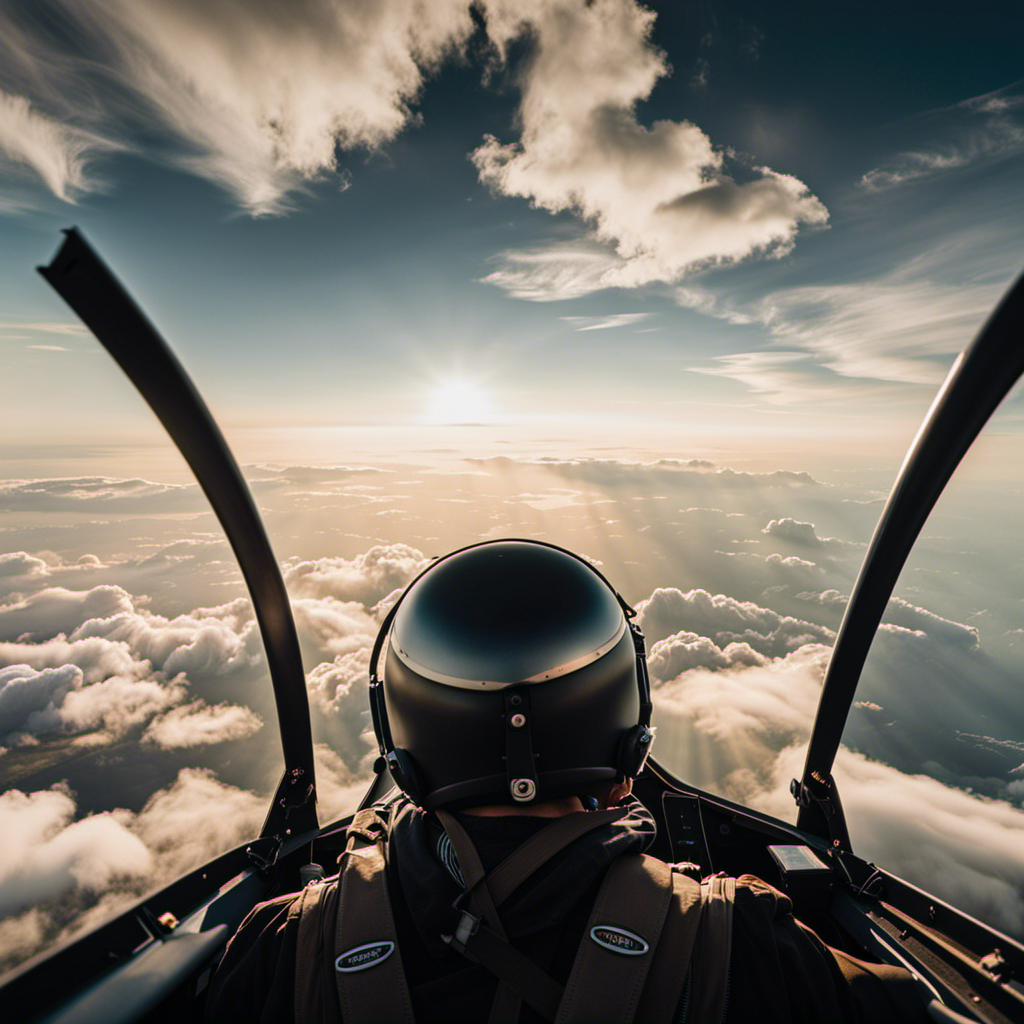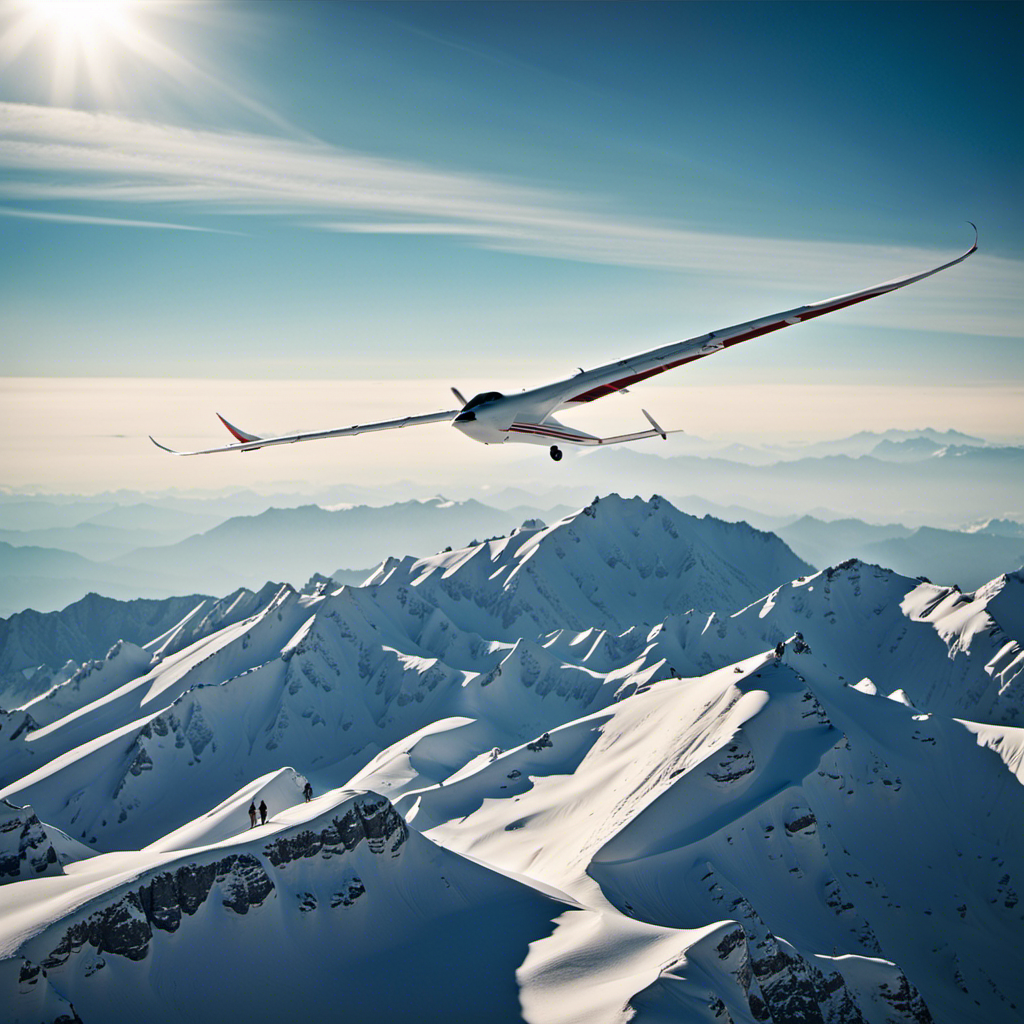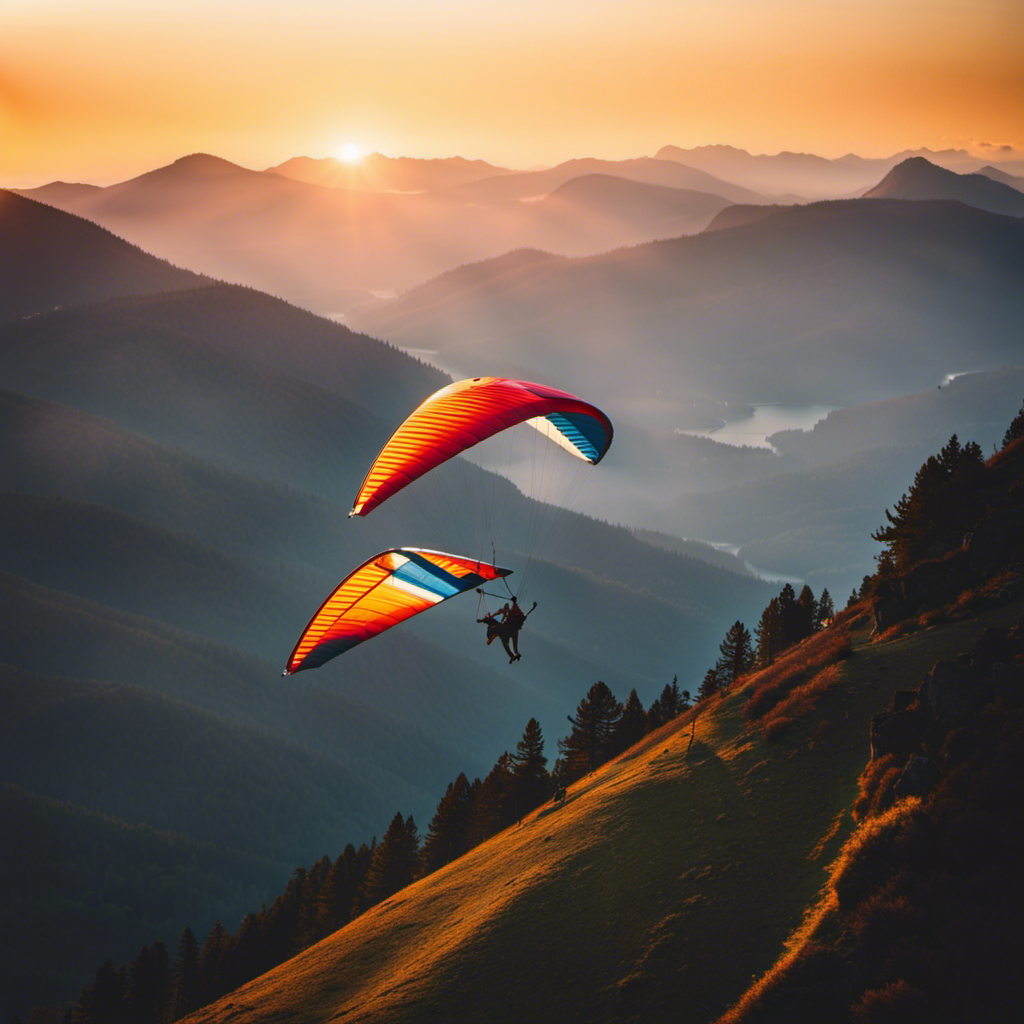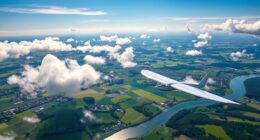Are you ready to take flight and experience the exciting world of gliding? Get ready for an incredible adventure by strapping in and bracing yourself!
In this beginner’s guide, I’ll be your trusted co-pilot, guiding you through the ins and outs of how to fly a glider.
From understanding the principles of flight to mastering takeoff and landing techniques, I’ll equip you with the knowledge and skills to soar like a pro.
Get ready to spread your wings and let’s dive into the world of gliding!
Key Takeaways
- Lift is generated by the interaction between the wing shape and airflow, so understanding aerodynamics and the role of the airfoil is crucial for successful gliding.
- Glider maintenance and pre-flight procedures are essential for safety and optimal performance, including regular inspections, following manufacturer guidelines, and thorough pre-flight checks.
- Proper takeoff techniques and landing procedures are important for a safe flight, including positioning the glider correctly, maintaining correct pitch attitude, and carefully planning the approach to the runway.
- Coordinating rudder and aileron inputs is necessary for control and stability, and executing smooth turns with precise control inputs enhances overall control and stability.
Understand the Principles of Flight
Now, let’s talk about how you can understand the principles of flight when flying a glider. To fully grasp the intricacies of glider flight, it is essential to comprehend the principles of lift and the aerodynamics involved.
Lift is the force that counteracts gravity and allows the glider to stay airborne. It is generated by the interaction between the shape of the wing and the flow of air over it. As the glider moves forward, air flows over the curved upper surface of the wing, creating a region of low pressure. This pressure differential between the upper and lower surfaces generates lift. The shape of the wing, known as the airfoil, plays a crucial role in maximizing lift and minimizing drag.
Understanding the aerodynamics of glider flight involves studying the various factors that affect performance, such as wing design, aspect ratio, and airspeed. By manipulating these variables, a pilot can optimize the glider’s efficiency and maneuverability.
Familiarize Yourself with the Glider’s Controls
First, you’ll want to get acquainted with the controls of your glider. Understanding how to operate the various controls is crucial for a safe and enjoyable flight. Let’s take a look at the table below, which outlines the primary controls and their functions:
| Control | Function |
|---|---|
| Control Stick | Controls the pitch and roll of the glider |
| Rudder Pedals | Controls the yaw of the glider |
| Spoilers | Used for speed control and descent |
| Flaps | Adjusts the lift and drag of the glider |
| Airbrakes | Enhances the descent rate and control |
| Instrument Panel | Displays vital flight information |
Glider maintenance is essential to ensure the safety and reliability of your aircraft. Regular inspections, proper cleaning, and adherence to manufacturer guidelines are crucial for optimal performance. Additionally, it is crucial to follow safety precautions such as wearing a helmet, using a safety harness, and conducting pre-flight checks.
Now that you are familiar with the glider’s controls, it’s time to learn the pre-flight procedures. These procedures involve inspecting the glider for any signs of damage, checking the control surfaces, verifying the proper functioning of instruments, and ensuring that all safety equipment is in place. By diligently following these procedures, you can ensure a safe and successful flight.
Transitioning into the subsequent section about ‘learn the pre-flight procedures’, it is important to thoroughly inspect your glider before taking to the skies.
Learn the Pre-flight Procedures
To ensure a safe and successful flight, make sure to thoroughly inspect your glider before taking to the skies. The pre-flight procedures are crucial for glider safety precautions.
Before every flight, it is essential to check the glider’s equipment and ensure that everything is in proper working order. This includes examining the wings, control surfaces, and landing gear for any signs of damage or wear. Additionally, inspecting the instrument panel, including the altimeter, variometer, and airspeed indicator, is vital to ensure accurate readings during the flight.
In addition to inspecting the glider’s equipment, it is essential to review the pre-flight checklist. This checklist outlines specific steps to follow before taking off, such as checking the fuel levels, verifying the weight and balance of the glider, and ensuring that all required documents and certificates are up-to-date. By carefully following this checklist, you can minimize the risk of any issues arising during the flight.
Transitioning into the subsequent section about practicing takeoff and landing techniques, it is crucial to have a solid foundation in pre-flight procedures. By thoroughly inspecting your glider and following the necessary safety precautions, you can ensure that you are ready to embark on the next step of your journey: mastering takeoff and landing techniques.
Practice Takeoff and Landing Techniques
Before practicing takeoff and landing techniques, it’s important to understand the key principles and procedures.
Takeoff techniques are crucial for a successful flight. The first step is to position the glider correctly on the runway, aligning it with the wind direction. This ensures maximum lift during takeoff. Next, the pilot needs to apply full control and smoothly increase the airspeed. It’s important to maintain the correct pitch attitude to prevent stalling or climbing too steeply. As the glider gains speed, the pilot should gently lift the nose wheel off the ground and allow the aircraft to naturally lift off.
During landing procedures, the pilot must carefully plan the approach to the runway. This involves adjusting the altitude, airspeed, and descent rate. The goal is to achieve a smooth touchdown by flaring the glider just above the runway surface. The pilot should then maintain directional control until the glider comes to a complete stop.
By mastering these takeoff techniques and landing procedures, you will have a solid foundation for safe and successful flights.
Now, let’s move on to the next section about mastering steering and turning.
Master Steering and Turning
When it comes to mastering steering and turning in a glider, two key points to focus on are coordinating rudder and aileron inputs and executing smooth turns.
Coordinating rudder and aileron inputs is crucial for maintaining control and stability during maneuvers. By properly coordinating these inputs, you can ensure that the glider responds smoothly and efficiently to your commands, allowing for precise control in turns.
Executing smooth turns requires a combination of precise control inputs, correct weight distribution, and maintaining the correct airspeed. By mastering these techniques, you can navigate turns with ease and precision, enhancing your overall flying experience.
Coordinating Rudder and Aileron Inputs
Make sure you’re smoothly coordinating your rudder and aileron inputs to maintain control and stability while flying the glider. This is crucial for maintaining altitude in thermals and ensuring a smooth flight. Here are three key points to keep in mind:
-
Balance: Coordinate your rudder and aileron inputs to maintain balance in the glider. Adjust the rudder to counteract adverse yaw, while using ailerons to control bank angle.
-
Precision: Make small, precise adjustments to avoid over-controlling the glider. Smooth and coordinated inputs will help you maintain the desired flight path.
-
Awareness: Stay aware of how your inputs affect the glider’s behavior. Pay attention to the yaw and roll axis, and make adjustments accordingly.
Executing Smooth Turns
Executing smooth turns requires coordinated inputs of the rudder and ailerons to maintain control and stability throughout the maneuver. When executing a turn, it is crucial to maintain proper altitude to ensure a safe and controlled flight.
To achieve this, the pilot must apply gentle pressure on the rudder pedals to initiate the turn, while simultaneously using the ailerons to bank the glider smoothly. By properly coordinating these inputs, the pilot can ensure that the glider maintains its desired trajectory and avoids any sudden changes in altitude.
It is essential to practice these maneuvers regularly to develop the necessary skills and instincts for executing smooth turns. Understanding thermals and soaring techniques further enhances the pilot’s ability to navigate through the air with precision and efficiency.
Understand Thermals and Soaring Techniques
To understand thermals and soaring techniques, you’ll need to learn how to read the wind patterns and identify areas of rising air. Thermals are columns of warm air that rise from the ground due to heating from the sun. These pockets of warm air can provide glider pilots with the lift needed to stay airborne and gain altitude. On the other hand, sink refers to areas of descending air where the glider loses altitude. By understanding the concepts of lift and sink, you can effectively navigate the sky and extend your flight time.
Reading wind patterns is crucial in identifying the presence of thermals. Winds blowing against the terrain, such as a hill or a mountain, can create updrafts. Additionally, observing the movement of clouds can also give you clues about the presence of thermals. Cumulus clouds, for example, are often associated with strong thermals.
To further illustrate the importance of understanding thermals and wind patterns, take a look at the table below:
| Wind Pattern | Effect on Glider |
|---|---|
| Headwind | Slows Down |
| Tailwind | Speeds Up |
| Crosswind | Sideways Drift |
| Updraft | Gain Altitude |
Learn Emergency Procedures
When faced with stall and spin situations while flying, it’s crucial to remain calm and employ the correct procedures to recover safely.
Understanding the aerodynamics behind stalls and spins, as well as practicing recovery techniques, is essential for every pilot.
Additionally, mastering the skill of handling crosswind landings is vital for safe and efficient landings in challenging wind conditions.
Dealing with Stall and Spin Situations
If you start to feel the glider stalling or spinning, remember to stay calm and take immediate action to recover control.
Dealing with turbulence in a glider requires a precise understanding of the aircraft’s aerodynamics. When encountering turbulent air, it’s crucial to maintain a steady airspeed and avoid abrupt control inputs.
If the glider does enter a stall, the first step is to lower the nose to regain airflow over the wings. To recover from a spin, the pilot needs to apply opposite rudder and aileron inputs to counteract the rotation. Additionally, reducing the angle of attack by pushing the control column forward will help break the spin.
Transitioning into the subsequent section about handling crosswind landings, it is essential to master this skill to ensure safe landings in challenging wind conditions.
Handling Crosswind Landings
Handling crosswind landings requires the pilot to make small adjustments to the controls to maintain alignment with the runway. It is crucial to master crosswind techniques for landing safety precautions.
Here are some key points to help you understand and improve your crosswind landing skills:
- Maintain a proper crab angle to counteract the wind drift.
- As you approach the runway, gradually transition from crabbing to a sideslip.
- Use the rudder to align the aircraft with the runway while maintaining a constant descent rate.
- Apply appropriate aileron inputs to prevent drifting off course.
By practicing these techniques, you will be able to confidently handle crosswind landings and ensure a safe touchdown.
Now, let’s move on to gaining experience with solo flights, which will further enhance your flying skills and build your confidence in the air.
Gain Experience with Solo Flights
Once you’re comfortable with the basics, it’s time to gain experience with solo flights. Solo flying is a significant milestone in your journey to becoming a skilled glider pilot. It allows you to put your skills to the test and overcome solo flight challenges while improving your flight techniques. During solo flights, you will face new experiences and learn to make decisions independently, enhancing your confidence and ability to handle different situations in the air.
To give you a glimpse of what you might encounter during solo flights, here is a table showcasing some common challenges and techniques to overcome them:
| Challenge | Technique | Emotion Invoked |
|---|---|---|
| Thermalling | Center the glider in the thermal | Excitement |
| Navigating | Use landmarks and GPS to stay on track | Focus |
| Landing | Establish correct approach speed | Determination |
| Dealing with turbulence | Maintain a steady course | Confidence |
| Emergency procedures | Follow the appropriate checklist | Composure |
As you gain experience through solo flights, you might find yourself yearning for more advanced training and certifications. This will enable you to explore new techniques, improve your skills, and broaden your horizons as a glider pilot.
Consider Advanced Training and Certifications
As an experienced glider pilot, I highly recommend pursuing a glider pilot license and participating in advanced glider competitions to further enhance your skills and knowledge in this exhilarating sport.
Obtaining a glider pilot license will not only provide you with the necessary qualifications to fly solo, but it will also open up opportunities for more challenging flights and advanced training.
Additionally, participating in advanced glider competitions will allow you to test your abilities against other skilled pilots, pushing you to excel and improve your performance.
Pursuing a Glider Pilot License
If you’re interested in pursuing a glider pilot license, there are a few steps you’ll need to take. Pilot training is an essential aspect of becoming a licensed glider pilot. It involves learning the fundamental principles of flight, navigation techniques, and emergency procedures. Safety measures are of utmost importance in glider flying, as you’ll be operating an aircraft without an engine. Understanding weather patterns, pre-flight checks, and emergency protocols are crucial for a safe and successful flight. To give you an overview of the process, here is a table outlining the steps involved in obtaining a glider pilot license:
| Steps | Description | Duration |
|---|---|---|
| Ground School | Classroom instruction on glider operations | 20 hours |
| Flight Training | Practical flying lessons under instructor guidance | 20-30 hours |
| Written Exam | Assessing theoretical knowledge | 1-2 hours |
| Checkride | Practical flight test with an examiner | 1-2 hours |
Once you have obtained your glider pilot license, you can then move on to participating in advanced glider competitions, where you can showcase your skills and compete with other experienced pilots.
Participating in Advanced Glider Competitions
To showcase your skills and compete with other experienced pilots, you’ll have the opportunity to participate in advanced glider competitions after obtaining your glider pilot license. These competitions are a great way to test your abilities and push the boundaries of glider flying.
Advanced glider technology plays a crucial role in these competitions, as pilots often rely on cutting-edge equipment and instruments to improve their performance. It is essential to stay updated with the latest advancements in glider technology to stay competitive.
Additionally, glider maintenance and repairs are crucial to ensure that your glider is in optimal condition for these competitions. Regular inspections and timely repairs are necessary to guarantee the safety and performance of your glider.
By participating in advanced glider competitions, you can not only demonstrate your skills but also learn from other experienced pilots and gain valuable insights into the world of gliding.
Joining a gliding club or community is the next step towards immersing yourself in this exhilarating sport.
Join a Gliding Club or Community
You should definitely consider joining a gliding club or community to immerse yourself in the world of gliding and learn from experienced pilots. Being a part of a gliding club not only provides you with a supportive and knowledgeable community, but it also offers various benefits that can enhance your gliding experience.
Here are four reasons why joining a gliding club or community is essential for any aspiring glider pilot:
-
Glider Safety Tips: By joining a gliding club, you gain access to a wealth of knowledge and expertise on glider safety. Experienced pilots can share their safety tips and best practices, helping you to navigate the skies with confidence and minimize risks.
-
Finding Glider Flying Locations: Gliding clubs often have well-established relationships with local authorities and landowners, granting them access to prime glider flying locations. As a member, you can take advantage of these exclusive flying spots and explore new areas that offer optimal conditions for gliding.
-
Networking Opportunities: Joining a gliding club allows you to connect with fellow glider enthusiasts who share your passion. Networking with experienced pilots can open doors to new opportunities, such as participating in group flights, cross-country gliding adventures, or even mentorship programs.
-
Continuous Learning: Gliding clubs frequently organize workshops, seminars, and training sessions to enhance your skills and knowledge. These educational opportunities enable you to stay updated on the latest gliding techniques, advancements in glider technology, and regulatory changes.
Joining a gliding club or community is a crucial step in your gliding journey. Not only will it provide you with invaluable resources and support, but it will also help you foster lifelong friendships with like-minded individuals who share your love for gliding.
So don’t hesitate, find a local gliding club and start soaring the skies!
Frequently Asked Questions
Are there any age restrictions for flying a glider?
Age restrictions for glider flying vary depending on the country and organization. Safety precautions, such as being physically fit and mentally alert, are essential for all pilots.
Can I fly a glider if I wear glasses or contact lenses?
When it comes to glider flying with visual impairments, wearing glasses or contact lenses is not a problem. However, there are alternatives available such as prescription goggles that can ensure clear vision during your flight.
How long does it take to learn how to fly a glider?
It takes approximately 20-30 hours of flight time to learn how to fly a glider. The learning curve varies depending on the individual, but acquiring the necessary skills, such as understanding aerodynamics and mastering control inputs, is essential.
Is it necessary to have a pilot’s license to fly a glider?
Of course, you don’t need a pilot’s license to fly a glider. It’s not like safety regulations and extensive training are important when operating an aircraft. Just hop in and go!
What are the costs associated with glider flying?
Glider maintenance and insurance are important factors to consider when calculating the costs of glider flying. Regular maintenance ensures the safety and performance of the glider, while insurance provides protection against potential damages or accidents.
Conclusion
In conclusion, flying a glider is an exhilarating experience that requires a thorough understanding of the principles of flight, mastery of controls, and adherence to pre-flight procedures.
Through practice and dedication, one can develop the skills needed to take off, land, steer, and navigate emergency situations.
Just like navigating the skies, life itself is a journey that requires knowledge, precision, and the ability to adapt to unexpected challenges.
Embrace the skies, spread your wings, and soar towards new heights, both in the air and in life.
